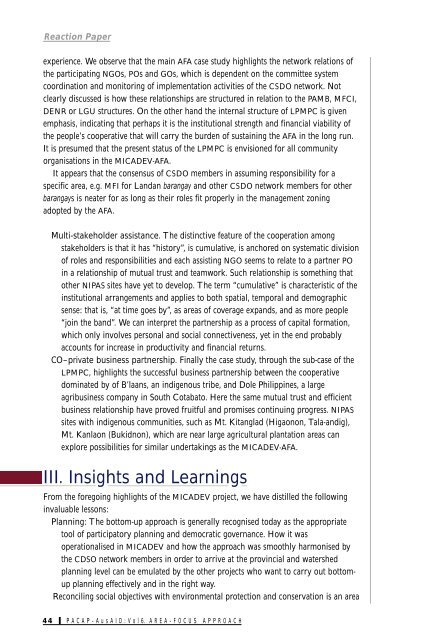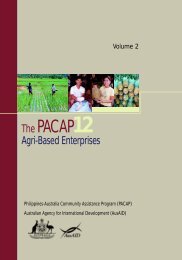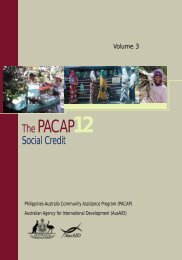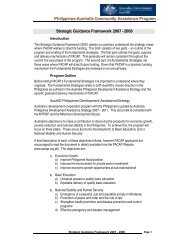The PACAP12
The PACAP12
The PACAP12
You also want an ePaper? Increase the reach of your titles
YUMPU automatically turns print PDFs into web optimized ePapers that Google loves.
Reaction Paper<br />
experience. We observe that the main AFA case study highlights the network relations of<br />
the participating NGOs, POs and GOs, which is dependent on the committee system<br />
coordination and monitoring of implementation activities of the CSDO network. Not<br />
clearly discussed is how these relationships are structured in relation to the PAMB, MFCI,<br />
DENR or LGU structures. On the other hand the internal structure of LPMPC is given<br />
emphasis, indicating that perhaps it is the institutional strength and financial viability of<br />
the people’s cooperative that will carry the burden of sustaining the AFA in the long run.<br />
It is presumed that the present status of the LPMPC is envisioned for all community<br />
organisations in the MICADEV-AFA.<br />
It appears that the consensus of CSDO members in assuming responsibility for a<br />
specific area, e.g. MFI for Landan barangay and other CSDO network members for other<br />
barangays is neater for as long as their roles fit properly in the management zoning<br />
adopted by the AFA.<br />
Multi-stakeholder assistance. <strong>The</strong> distinctive feature of the cooperation among<br />
stakeholders is that it has “history”, is cumulative, is anchored on systematic division<br />
of roles and responsibilities and each assisting NGO seems to relate to a partner PO<br />
in a relationship of mutual trust and teamwork. Such relationship is something that<br />
other NIPAS sites have yet to develop. <strong>The</strong> term “cumulative” is characteristic of the<br />
institutional arrangements and applies to both spatial, temporal and demographic<br />
sense: that is, “at time goes by”, as areas of coverage expands, and as more people<br />
“join the band”. We can interpret the partnership as a process of capital formation,<br />
which only involves personal and social connectiveness, yet in the end probably<br />
accounts for increase in productivity and financial returns.<br />
CO–private business partnership. Finally the case study, through the sub-case of the<br />
LPMPC, highlights the successful business partnership between the cooperative<br />
dominated by of B’laans, an indigenous tribe, and Dole Philippines, a large<br />
agribusiness company in South Cotabato. Here the same mutual trust and efficient<br />
business relationship have proved fruitful and promises continuing progress. NIPAS<br />
sites with indigenous communities, such as Mt. Kitanglad (Higaonon, Tala-andig),<br />
Mt. Kanlaon (Bukidnon), which are near large agricultural plantation areas can<br />
explore possibilities for similar undertakings as the MICADEV-AFA.<br />
III. Insights and Learnings<br />
From the foregoing highlights of the MICADEV project, we have distilled the following<br />
invaluable lessons:<br />
Planning: <strong>The</strong> bottom-up approach is generally recognised today as the appropriate<br />
tool of participatory planning and democratic governance. How it was<br />
operationalised in MICADEV and how the approach was smoothly harmonised by<br />
the CDSO network members in order to arrive at the provincial and watershed<br />
planning level can be emulated by the other projects who want to carry out bottomup<br />
planning effectively and in the right way.<br />
Reconciling social objectives with environmental protection and conservation is an area<br />
44 P A C A P - A u s A I D : V o l 6. A R E A - F O C U S A P P R O A C H







